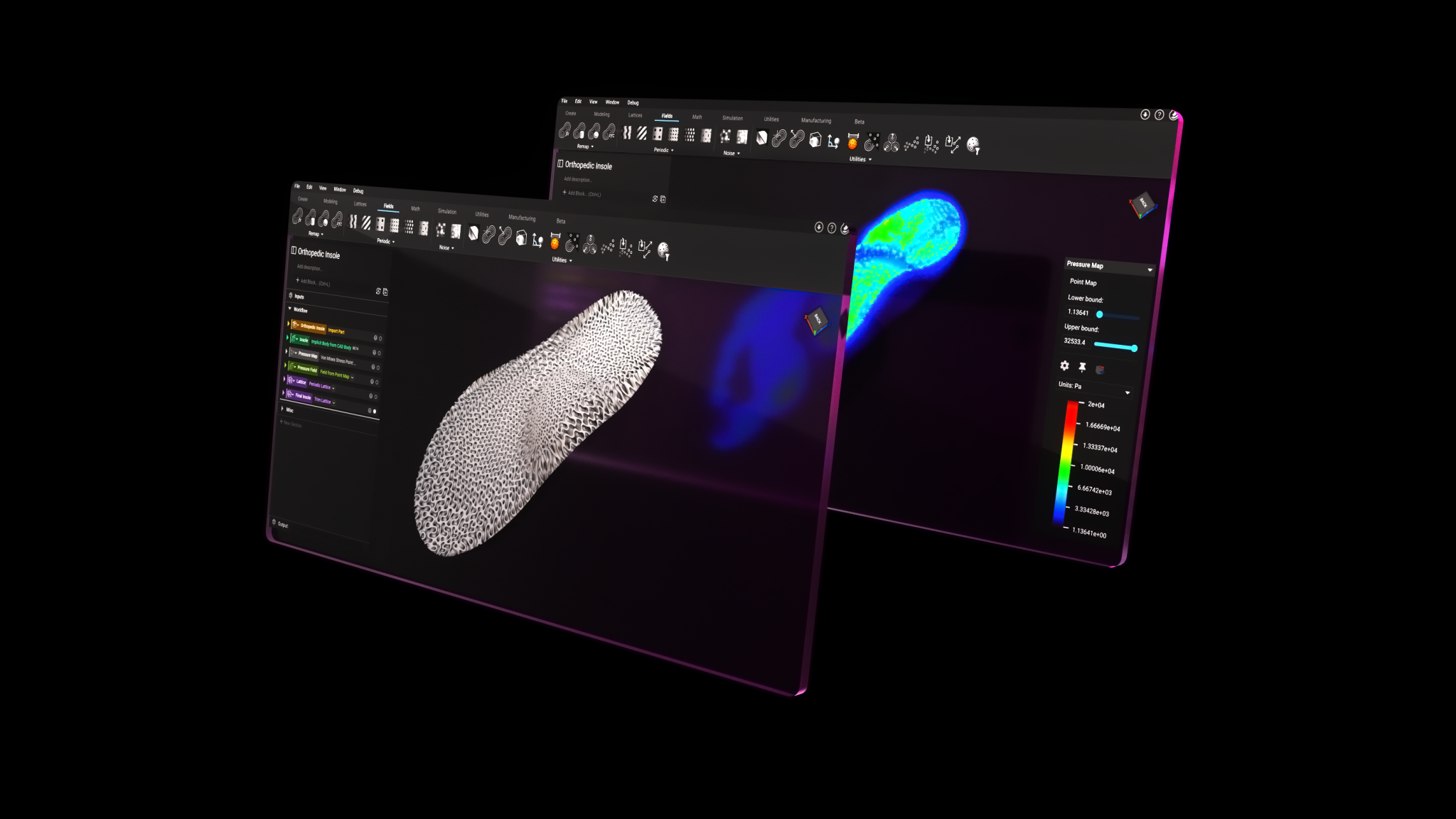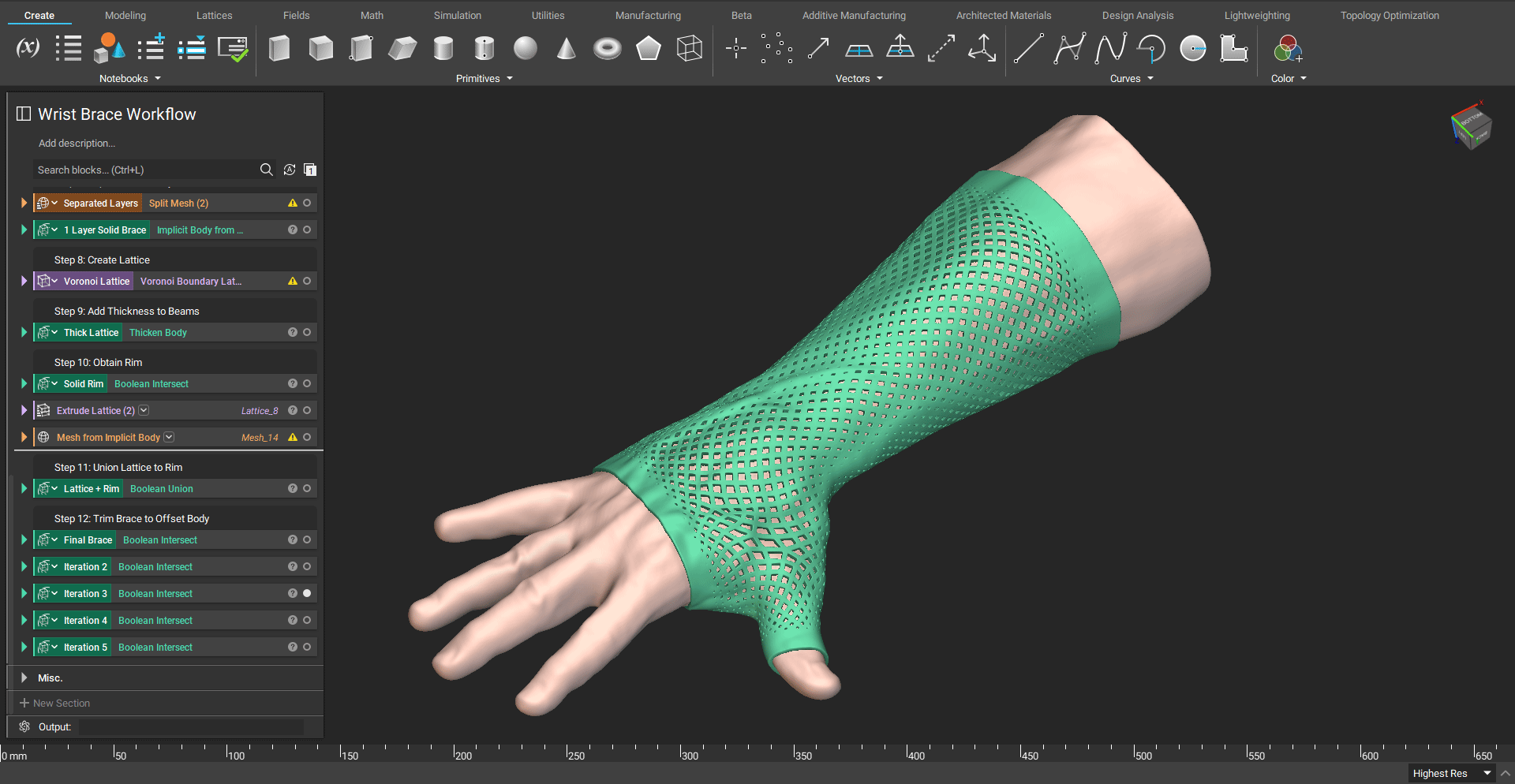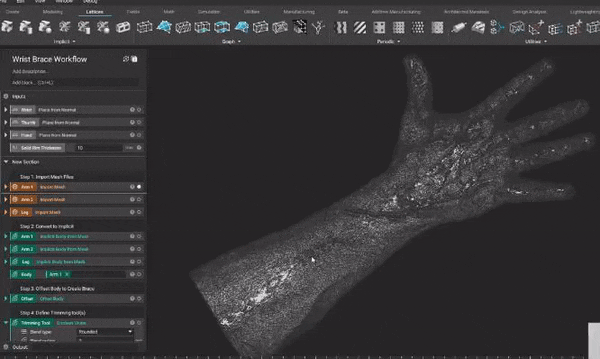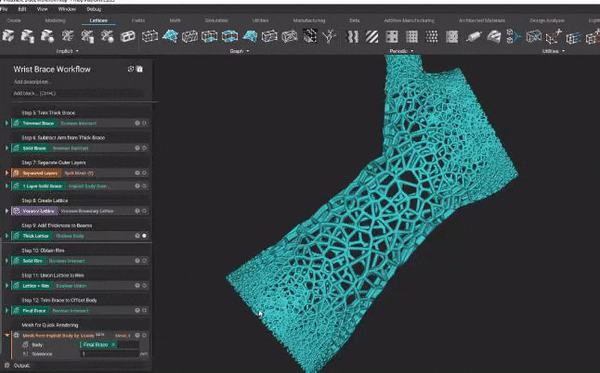3D printing orthotics: A complete guide

Written by nTop
Published on January 24, 2023
This article explores how 3D printing orthoses, paired with a fully digital fabrication process, creates new opportunities for healthcare providers to innovate, improve patient outcomes, and reduce the cost of care.
Personalized medical devices are growing in popularity among healthcare providers because they have been clinically proven to improve patient outcomes and reduce the cost of care. Demand for 3D-printed custom orthotic devices, in particular, is increasing due to their potential for better comfort and improved user satisfaction. However, traditional orthotic fabrication workflows are limited by the manual labor and expertise required to execute them, which can drive up costs, limit innovation, and reduce efficiency.
The advent of digital workflows is providing additional options for healthcare providers to personalize medical devices to individual patients. This technology, paired with 3D printing, enables greater precision during the design process, can improve turnaround times, and minimize waste materials, among other benefits.
Despite the advantages of orthoses designed and manufactured with a digital workflow, these devices still occupy a relatively small portion of the market. This article will explore how digital workflows compare with traditional workflows in designing 3D-printed orthoses and outline key factors to consider when creating these devices.
Additive manufacturing and orthotics

Patient-specific wrist-hand orthosis.
Personalized medical devices allow healthcare providers to tailor treatments to each patient. Personalization is especially important in orthotic devices, which are externally applied devices that influence the functional and structural characteristics of the patient's skeletal and neuromuscular system. Orthoses must be carefully customized to the patient's unique physiology and needs.
3D printing, also known as additive manufacturing (AM), is revolutionizing the field of orthotics by enabling healthcare providers to provide personalized medical devices more quickly, easily, and efficiently. Using 3D scanning data, AM enables you to accurately tailor a device to a patient’s unique physiology at a fraction of the cost and in significantly less time than traditional manufacturing methods require. 3D printing has been used in orthotics for ankle-foot orthoses, orthopedic insoles, spine braces, head orthoses, and much more.
The level of control you can achieve with 3D printing, particularly in the development of biologically relevant structures impossible to manufacture with traditional methods, can improve the patient’s comfort levels and the device’s performance. AM also eliminates the need for expensive tooling traditionally required for manufacturing custom orthoses and is highly scalable, making mass customization more economically viable. Moreover, with its faster development cycles, AM facilitates rapid design iteration and improved fit.
Another benefit of 3D printing orthoses is that it allows you to introduce more dynamic behavior than traditional designs. For example, you could create stiff and flexible areas in the same design and perforation patterns to improve breathability and hygiene.
Clinical studies have shown that custom wrist, hand, foot, and ankle orthoses have similar or superior effects on biomechanical and kinematic parameters while scoring higher in user satisfaction and comfort than conventional orthoses.
How digital workflows support additive manufacturing

Creating a custom cast based on patient data in nTop.
While traditional custom orthoses are manufactured through a manual process requiring skilled technicians, AM allows you to introduce fully digital workflows that can reduce wait times and the number of patient visits necessary to fabricate custom orthotic devices.
Digital workflows offer a range of advantages when used in conjunction with additive manufacturing technologies. By leveraging 3D imaging or scanning data and procedural or parametric software, digital workflows enable the rapid iteration and generation of prototypes, even by non-expert users. This can be especially useful when creating complex geometric objects such as wrist splints and ankle-foot orthoses from 3D scans.
The digital workflow for orthotics
The digital workflow for personalized medical devices varies depending on the use case, but the basic steps remain the same.
1. Patient data acquisition
The first step in designing custom orthoses is acquiring high-resolution anatomical data using 3D medical imaging technologies. You can obtain this data using a handheld 3D scanner, CT scan, or MRI. You will then segment and convert the data into digital surface meshes used in downstream design operations. The clinician might provide other relevant patient-specific data at this stage to inform the treatment plan.
2. Design generation
Depending on the use case and customization strategy, you will generate the device's design according to your chosen level of automation — from one-off manual designs to fully automated patient-matched devices. At this stage, you will also design any custom instrumentation necessary to deliver the device to the patient. Remember that the design process is as essential as the design output because it supports compliance with best practices and medical protocol.
3. Manufacturing
You can use AM to produce orthoses either directly or indirectly by creating custom tooling for the primary manufacturing process. Generally, the direct approach is preferable when creating devices with features that are only possible with 3D printing. However, the economics of the indirect method can scale better when producing in large volumes.
In both cases, you will need to subject the device to specific post-processing after manufacturing to ensure that all functional requirements are met and potentially to improve the device's aesthetics.
4. Delivery to the patient
Since you have designed the orthosis to match the patient's unique anatomy, fitting the device should be comparatively simple. On the other hand, stock orthoses may require adjustment during the fitting process.
Advantages of digital over traditional fabrication processes
The first advantage of using digital fabrication for orthotic production is that it reduces product lead time dramatically. Traditional processes require molds and casts, which are usually created manually by technicians, making them slower and less precise than their digital counterparts.
Secondly, digital fabrication reduces material costs by eliminating the need for certain materials and components. Traditional production of orthoses typically involves several labor-intensive steps such as casting, molding, and gluing, which require various costly materials. In the case of 3D printing, however, only the necessary material is needed, resulting in significant cost savings.
Lastly, digital fabrication offers more design flexibility than traditional methods, allowing designers to rapidly iterate without needing to produce multiple prototypes. Digital workflows can also be replicated easily, allowing you to quickly input new patient data to generate pre-validated designs.
Important design considerations
Validating your workflow
Validating a digital workflow for orthotics is an important step in maximizing efficiency, minimizing costs, and ensuring the best outcome for the patient. To evaluate the quality of a digital workflow, you should consider the following parameters:
- Repeatability: the consistency of output data over time from a stationary or fixed target.
- Reliability: the degree to which your measurements, calculations, and specifications can be relied on to be accurate.
- Accuracy: how close a measurement is to its actual value.
- Final fit: how well the printed, finalized device fits the patient.
Design automation
Design automation is a critical factor when designing orthotic devices because it can help reduce the time and cost associated with creating personalized medical devices. You can introduce automation at every stage of the product development process.
Research and development
In the research and development stage, design automation allows you to quickly explore the available design space, identify important variables, and lock in critical parameters. Usually, the research and development stage leads to an automated design workflow that only needs new inputs to generate a pre-validated design.
The production environment
Once your workflow is ready, you can deploy it in the production environment. Using a streamlined interface allows non-expert users to run automated design processes with patient-specific data as inputs. They can also visually inspect and troubleshoot the results with minimal skill or expertise.
To support economic viability
Lastly, once production volume reaches a critical threshold, you can introduce design automation through a programmatic environment to support economic viability. For instance, scripts that run on a server or the cloud and call upon design generation workflows can reduce manual design time and the associated costs.

Foot insole design, demonstrating data-driven design in nTop.
Data-driven design is another important consideration when designing orthotic devices. By embracing data-driven design, you can use patient-specific data to drive design variables to tailor orthotic devices to an individual's physiology. This data can come from direct measurements or simulation data.
Software for designing 3D-printed orthoses

With the increasing popularity and widespread use of 3D printing, there is a rising demand for software that can take full advantage of its design freedom. nTop is a next-generation design software that enables engineers to create innovative medical devices that are more accessible, reduce the cost of care, and improve patient outcomes.
With nTop, you can quickly and easily design custom medical devices that meet the unique needs of your patients. Find out more about personalized medical devices in our comprehensive guide.
Key takeaways
- Customized orthotic devices are common, but traditional workflows rely on a high level of skill and require laborious, manual processes.
- Orthoses production that leverages a digital workflow is becoming more popular, maximizing efficiency, reducing lead times, and driving down costs.
- Advanced engineering design software like nTop can help you access the benefits of a fully digital workflow and significantly improve your 3D-printed orthotic designs.

nTop
nTop (formerly nTopology) was founded in 2015 with the belief that engineers’ ability to innovate shouldn’t be limited by their design software. Built on proprietary technologies that upend the constraints of traditional CAD software while integrating seamlessly into existing processes, nTop allows designers in every industry to create complex geometries, optimize instantaneously, and automate workflows to develop breakthrough parts and systems in record time.
Related content
- VIDEO
When your design changes, how fast can you respond?

- CASE STUDY
Replacing spacecraft supermaterial with high-performance lattice

- VIDEO
Creating a computational design workflow to lightweight drone panels with nTop’s new ribbing tools

- WEBINAR
Accelerating Product Engineering with Computational Design

- CASE STUDY
Reducing weight to help win and withstand the rigors of a 24 hour Le Mans race
